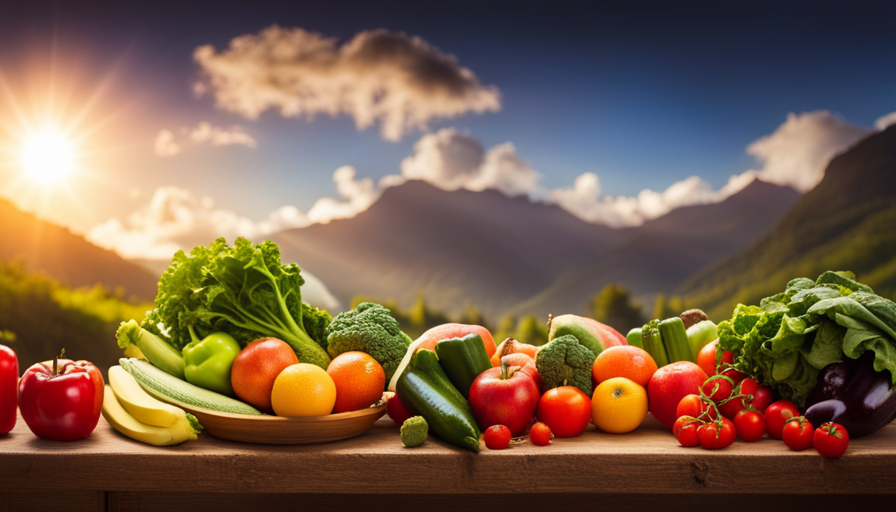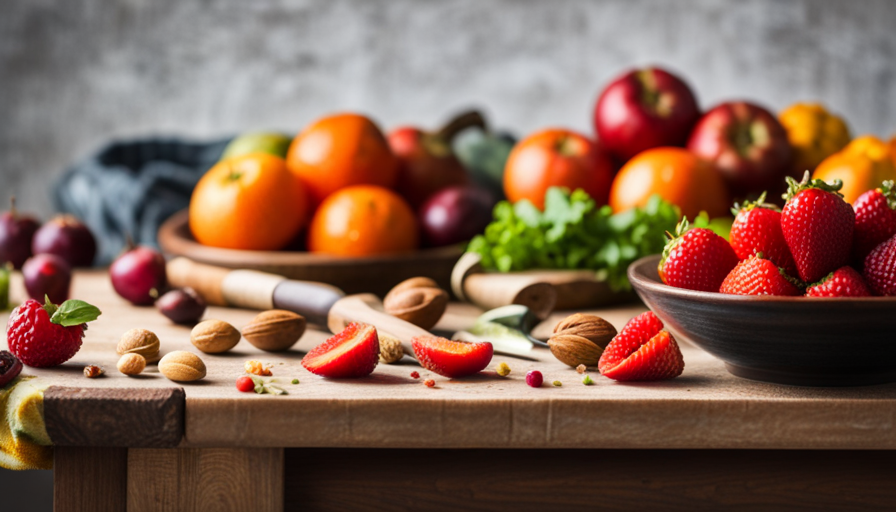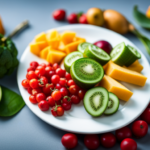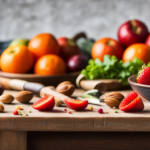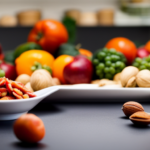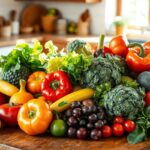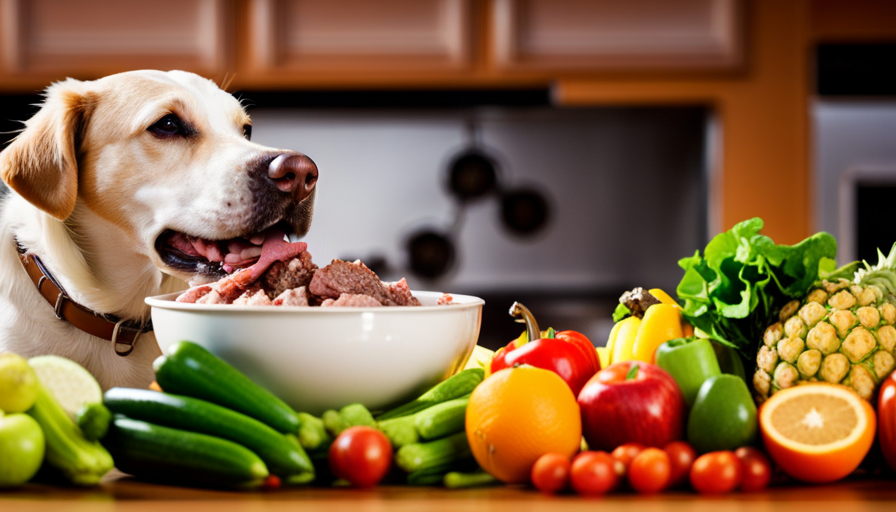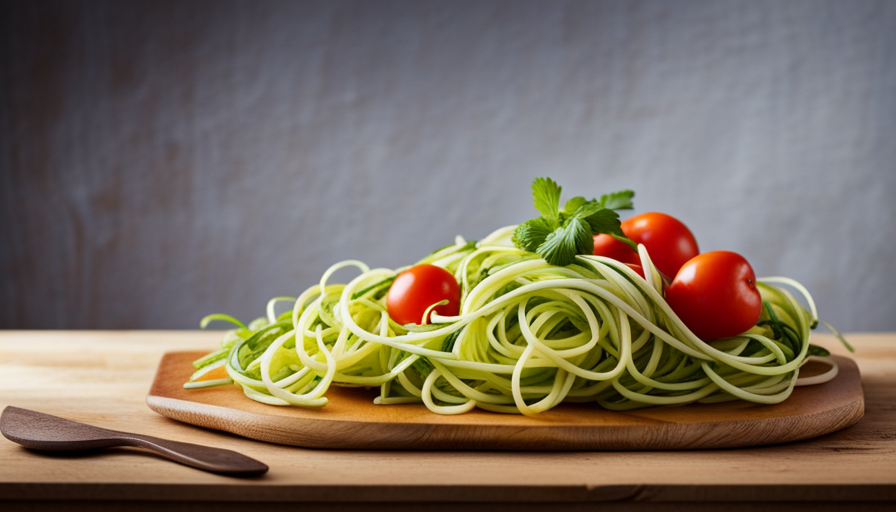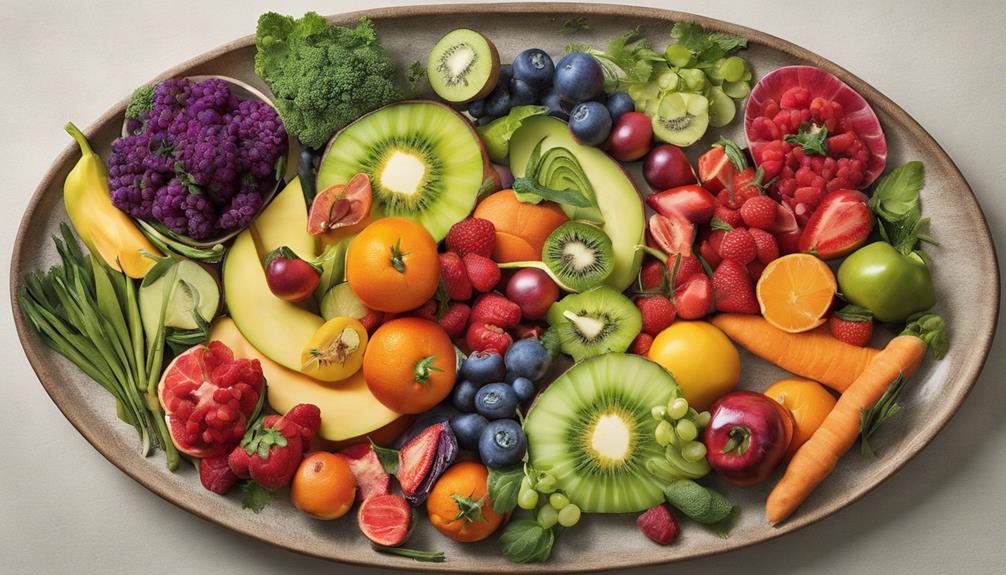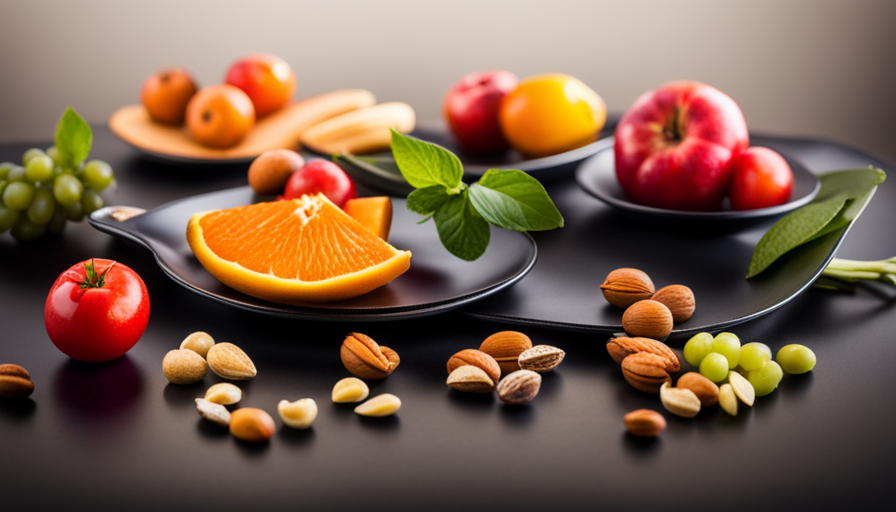Imagine this: you are walking through a lively farmers market, surrounded by a variety of fresh fruits and vegetables. The colors, smells, and textures stimulate your senses, making you curious about how you can fully enjoy the natural benefits of these foods.
Enter the raw food diet. As a nutritionist, I’ve often encountered questions about the safety of this dietary trend. Can we truly thrive on uncooked, unprocessed foods alone?
In this article, we will explore the raw food diet from an evidence-based perspective, examining its nutritional considerations, potential benefits, and possible risks. We’ll also delve into the importance of food safety and personalization when adopting this lifestyle.
So, if you’re curious about the raw food diet and its safety, join me on this informative journey to separate fact from fiction and make an informed decision about your dietary choices.
Key Takeaways
- Transitioning to a raw food diet should be a gradual process and it is important to consult with a healthcare professional before starting.
- There may be potential nutrient deficiencies in a raw food diet, but these can be mitigated through the use of fortified foods and supplements.
- Proper handling and storage of raw foods is crucial for food safety, as there is a risk of foodborne illnesses.
- Personalization and moderation are important in a raw food diet, and it is necessary to find the right balance for a safe and enjoyable experience.
Understanding the Raw Food Diet
Now that you’ve learned about the raw food diet, let’s dive deeper into its safety and whether it’s the right choice for you.
There are some misconceptions surrounding the raw food diet that need to be addressed. One common misconception is that a raw food diet means only eating uncooked vegetables and fruits. While these are important components, a raw food diet can also include nuts, seeds, sprouted grains, and fermented foods.
Transitioning to a raw food diet can be a gradual process. It’s recommended to start by increasing the amount of raw foods in your diet and gradually reducing the intake of cooked foods. This allows your body to adjust to the changes and ensures a smooth transition.
It’s important to note that a raw food diet may not be suitable for everyone, especially those with certain medical conditions or nutrient deficiencies. It’s always a good idea to consult with a healthcare professional or registered dietitian before making any major dietary changes.
Moving on to the next section about nutritional considerations, it’s important to understand the potential benefits and challenges of a raw food diet.
Nutritional Considerations
Additionally, it’s important to consider the potential impact on my overall health and well-being when following a diet that primarily consists of uncooked and unprocessed ingredients. The raw food diet is considered an alternative diet that emphasizes the consumption of raw fruits, vegetables, nuts, and seeds. However, it is crucial to be aware of the potential nutrient deficiencies that may arise. The diet excludes cooked and processed foods, so certain nutrients like vitamin B12, iron, and calcium may be lacking. These nutrients are commonly found in animal products, which aren’t typically consumed on a raw food diet.
To mitigate these deficiencies, it’s recommended to incorporate fortified foods or supplements into the diet. Additionally, proper food preparation techniques, such as soaking and sprouting, can enhance nutrient availability. It’s important to consult with a healthcare professional or registered dietitian before embarking on the raw food diet to ensure that all nutritional needs are being met.
Transitioning into the subsequent section about the benefits of the raw food diet, it’s essential to weigh the potential risks and benefits before making any dietary changes.
Benefits of the Raw Food Diet
One amazing advantage of embracing the raw food lifestyle is the potential for increased energy levels and a vibrant, revitalized body. Many people who follow a raw food diet report feeling more energetic and alive than ever before. This is because raw foods are packed with essential nutrients and enzymes that are often lost during the cooking process. By eating raw foods, we’re able to maximize the nutritional benefits of our food, leading to improved digestion and overall health.
In addition to increased energy levels, the raw food diet has been linked to weight loss. Raw foods are typically lower in calories and higher in fiber than cooked foods, making them a great option for those looking to shed a few pounds. The high fiber content also helps to improve digestion by promoting regular bowel movements and preventing constipation.
While the raw food diet offers many benefits, it’s important to note that there are potential risks and drawbacks as well. It can be challenging to get all the necessary nutrients on a raw food diet, and some people may experience difficulties in maintaining a balanced diet. Additionally, certain raw foods, such as unpasteurized dairy products and raw meat, can pose a risk of foodborne illnesses.
In the next section, we’ll explore these potential risks and drawbacks in more detail.
Potential Risks and Drawbacks
Watch out for the potential risks and drawbacks of the raw food lifestyle and make sure you’re aware of the challenges that may come with it. While the raw food diet offers numerous benefits, it also carries some risks that need to be considered.
One potential risk is the increased susceptibility to foodborne illnesses. Raw foods, especially fruits and vegetables, can harbor harmful bacteria such as Salmonella and E. coli. These pathogens can cause severe illness and even death in some cases, especially in individuals with weakened immune systems.
Another drawback of the raw food diet is the potential for nutrient deficiencies. Cooking certain foods can enhance their nutrient availability, making them easier for our bodies to absorb. For example, cooking tomatoes increases the bioavailability of lycopene, a powerful antioxidant. By solely relying on raw foods, you may miss out on these important nutrients.
It is crucial to ensure you are getting a well-balanced diet that meets all your nutritional needs. As we delve further into the topic of raw food preparation and food safety, it is essential to understand how to minimize these risks and drawbacks while still enjoying the benefits of a raw food lifestyle.
Raw Food Preparation and Food Safety
When it comes to raw food preparation and food safety, there are two key points to keep in mind:
-
Proper handling and storage of raw foods, as well as techniques for preparing raw meals. It’s crucial to follow good hygiene practices when handling raw foods to prevent cross-contamination and the spread of harmful bacteria.
-
Learning various techniques for preparing raw meals, such as soaking, sprouting, and marinating, can help enhance the flavors and textures of raw dishes while ensuring their safety.
Proper handling and storage of raw foods
Make sure you handle and store your raw foods properly to ensure their safety and prevent any potential harm. Here are some key handling techniques and food preservation tips to keep in mind:
-
Wash your hands thoroughly before and after handling raw foods to avoid cross-contamination.
-
Use separate cutting boards and utensils for raw meats, fruits, and vegetables to prevent the spread of bacteria.
-
Store raw foods in sealed containers or bags to prevent contact with other foods and avoid contamination.
-
Keep raw meats and seafood on the bottom shelf of the refrigerator to prevent their juices from dripping onto other foods.
-
Check the expiration dates of raw foods and discard any that are past their prime.
By following these guidelines, you can reduce the risk of foodborne illnesses and ensure the safety of your raw food diet.
Now, let’s explore some techniques for preparing raw meals.
Techniques for preparing raw meals
To create delicious and nutritious raw meals, you’ll need to master a variety of techniques that will elevate your culinary skills and keep your taste buds wanting more. Raw food recipes offer a wide range of options, from vibrant salads to flavorful wraps and refreshing smoothies. These recipes often feature fresh fruits, vegetables, nuts, and seeds that are packed with essential nutrients and enzymes. By consuming these raw ingredients, you can experience numerous health benefits, such as improved digestion, increased energy levels, and enhanced immune function. Additionally, preparing raw meals allows you to preserve the natural flavors and textures of the ingredients, resulting in a truly sensory experience. Incorporating these techniques into your cooking repertoire will not only support your well-being but also provide you with a delectable and satisfying dining experience. Now, let’s explore how personalization and moderation play a key role in maintaining a balanced raw food diet.
Personalization and Moderation
It’s important to find a balance with the raw food diet to ensure it’s safe and enjoyable for each individual. Personalization and moderation are key factors in making this diet sustainable in the long run. Here are three important considerations when it comes to personalizing and moderating your raw food meals:
-
Individual preferences: Everyone has different tastes and preferences when it comes to food. It’s essential to incorporate foods that you enjoy and make you feel satisfied. Experiment with different fruits, vegetables, nuts, and seeds to find the ones that suit your palate. This will make your raw food journey more enjoyable and sustainable.
-
Portion control: While raw food is generally healthy, it’s important to practice portion control. Consuming excessive amounts of certain foods can lead to nutrient imbalances or excessive calorie intake. Be mindful of the quantities you consume, especially when it comes to calorie-dense foods like nuts and seeds. Consulting a nutritionist or dietitian can help you determine the right portion sizes for your individual needs.
-
Seek guidance: Embarking on a raw food diet can be overwhelming, especially if you’re new to it. Seeking guidance from experts or joining support groups can provide you with valuable information and tips to navigate this lifestyle. They can offer personalized advice based on your specific needs and help you stay on track with your goals.
By considering individual preferences and practicing portion control, you can personalize and moderate your raw food diet effectively. Remember, finding the right balance is crucial for a safe and enjoyable experience.
Frequently Asked Questions
Are there any specific foods that should be avoided on a raw food diet?
Are there any specific foods that should be avoided on a raw food diet?
When following a raw food diet, it’s important to be aware of certain foods that may pose potential risks. Some foods to avoid include raw eggs, raw meat, unpasteurized dairy products, and certain types of fish like sushi-grade fish.
These foods can increase the risk of foodborne illnesses caused by bacteria or parasites. It’s crucial to properly handle and prepare raw foods to minimize these risks.
Can a raw food diet provide enough protein and other essential nutrients?
A raw food diet can provide enough protein and other essential nutrients if properly planned. While it may be challenging to meet protein needs solely from plant-based sources, there are options such as nuts, seeds, beans, and legumes.
However, nutrient deficiencies can occur if the diet is not well-balanced and lacks variety. It’s important to ensure adequate intake of vitamins, minerals, and omega-3 fatty acids by including a variety of fruits, vegetables, and whole grains in the diet.
Can a raw food diet be followed by pregnant women or individuals with certain medical conditions?
Pregnant women should exercise caution when considering a raw food diet. Research shows that a study of 500 pregnant women found that those who followed a raw food diet had a higher risk of nutrient deficiencies, including folate and iron.
Additionally, individuals with certain medical conditions, such as compromised immune systems or digestive disorders, may also need to avoid a raw food diet due to the risk of foodborne illnesses.
It’s important to consult with a healthcare professional before making any dietary changes.
Are there any potential long-term effects or health risks associated with a raw food diet?
There may be potential long-term effects and health risks associated with a raw food diet. While it can provide essential nutrients, it may not provide all the necessary vitamins and minerals needed for optimal health. Additionally, there is a risk of foodborne illnesses from consuming raw or undercooked foods.
It’s important to consult with a healthcare professional or registered dietitian before starting a raw food diet to ensure it’s safe and meets individual nutritional needs.
How can one ensure food safety and prevent foodborne illnesses when following a raw food diet?
To ensure food safety and prevent foodborne illnesses when following a raw food diet, it’s important to take certain precautions.
Firstly, thoroughly wash all fruits and vegetables before consumption.
Secondly, handle raw foods separately from cooked foods to avoid cross-contamination.
Additionally, store perishable items at the proper temperature to prevent bacterial growth.
Lastly, stay informed about food recalls and be mindful of potential risks associated with consuming raw or undercooked foods.
Following these guidelines can help minimize the risk of foodborne illnesses.
Are there any potential risks or dangers associated with the raw food diet?
Yes, there are potential risks associated with the raw food diet. Some toxic raw food hazards include contamination from bacteria, parasites, and foodborne illnesses. Consuming raw animal products like meat and eggs can increase the risk of food poisoning. It’s important to handle and prepare raw foods carefully to minimize these dangers.
Conclusion
In conclusion, the raw food diet can be a safe and healthy option for some individuals. It provides numerous benefits, including increased nutrient intake and improved digestion. However, it is important to consider potential risks and drawbacks, such as nutrient deficiencies and foodborne illnesses.
By properly preparing and handling raw foods, and personalizing the diet to meet individual needs, one can enjoy the benefits of this lifestyle while minimizing potential risks. Remember, moderation is key. So, if you’re considering the raw food diet, proceed with caution and make informed decisions for your health.

